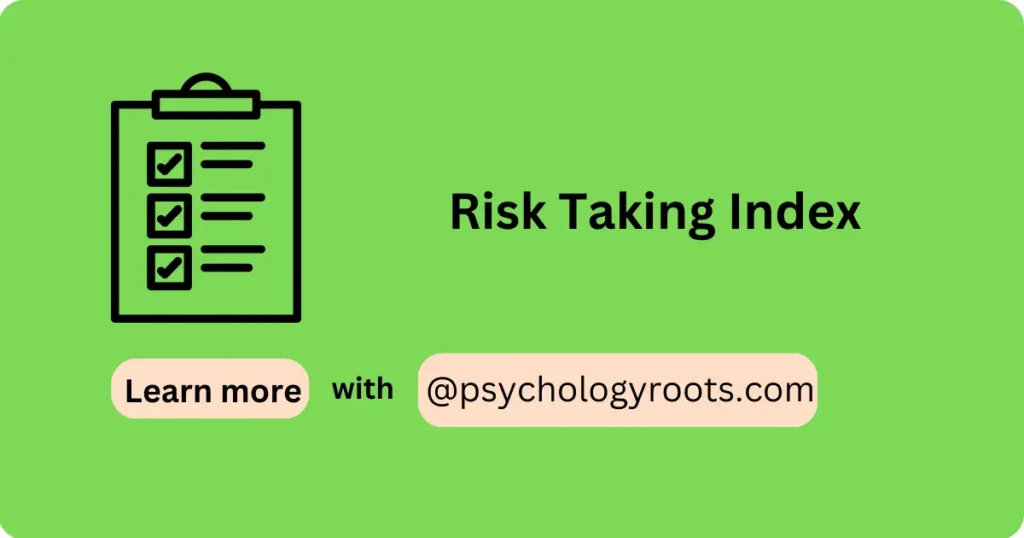Table of Contents
Risk Taking Index
Here in this post, we are sharing the “Risk Taking Index”. You can read psychometric and Author information. We have thousands of Scales and questionnaires in our collection (See Scales and Questionnaires). You can demand us any scale and questionnaires related to psychology through our community, and we will provide you with a short time. Keep visiting Psychology Roots.
About Scale Name
Scale Name
Risk Taking Index also known as the Risk Propensity Scale
Author Details
Nicholson, Soane, Fenton-O’Creevy, and Willman
Translation Availability
Not Sure

Background/Description
The Risk Taking Index (RTI) is a self-report measure of risk taking that was developed by Nicholson, Soane, Fenton-O’Creevy, and Willman (2005). The RTI was developed in response to the need for a reliable and valid measure of risk taking that could be used in a variety of settings, including research, clinical practice, and organizational settings.
The RTI is based on the concept of risk propensity, which is the tendency to take risks in everyday life. Risk propensity is a complex construct that is influenced by a variety of factors, including personality, cognitive style, and cultural background. The RTI is designed to measure risk propensity across six domains:
- Recreational risks (e.g., rock climbing, scuba diving)
- Health risks (e.g., smoking, poor diet, high alcohol consumption)
- Career risks (e.g., quitting a job without another to go to)
- Financial risks (e.g., gambling, risky investments)
- Safety risks (e.g., fast driving, city cycling without a helmet)
- Social risks (e.g., standing for election, publicly challenging a rule or decision)
Each item on the RTI is rated on a scale of 1 (never) to 5 (very often). Higher scores on the RTI indicate a higher tendency to take risks.
The RTI has been shown to be a reliable and valid measure of risk taking. It has been used in a variety of research studies to examine the relationship between risk taking and personality, decision making, and other psychological constructs. The RTI has also been used in clinical settings to assess risk taking in individuals with gambling problems and other addictive behaviors.
The RTI is a useful tool for assessing risk taking in everyday life. It can be used to identify individuals who are more or less likely to take risks, and to examine the relationship between risk taking and other psychological constructs. The RTI can also be used to assess risk taking in clinical settings and to develop interventions to help individuals manage their risk taking behavior.
Administration, Scoring and Interpretation
- Provide the participant with a copy of the RTI.
- Instruct the participant to read each item carefully and to rate how often they have engaged in the behavior described in the item.
- The participant should rate each item on a scale of 1 (never) to 5 (very often).
- Once the participant has rated all of the items, they should add up their scores.
Reliability and Validity
The Risk Taking Index (RTI) has been shown to be a reliable and valid measure of risk taking.
Reliability refers to the consistency of the measure. The RTI has been shown to have good test-retest reliability, meaning that people who score high on the RTI one time are likely to score high on the RTI again at a later time. The RTI also has good internal consistency, meaning that the items on the RTI are all measuring the same underlying construct of risk taking.
Validity refers to the extent to which the measure measures what it is supposed to measure. The RTI has been shown to have good convergent validity, meaning that it correlates with other measures of risk taking. The RTI has also been shown to have good discriminant validity, meaning that it does not correlate with measures of other constructs, such as personality and intelligence.
Available Versions
06-Items
Reference
Nicholson, N., Soane, E., Fenton-O’Creevy, M., & Willman, P. (2005). Personality and domain-specific risk taking. Journal of Risk Research, 8(2), 157-176.
Important Link
Scale File:
Frequently Asked Questions
What is the RTI?
The RTI is a self-report measure of risk taking.
Who developed the RTI?
The RTI was developed by Nicholson, Soane, Fenton-O’Creevy, and Willman (2005).
What does the RTI measure?
The RTI measures risk propensity, which is the tendency to take risks in everyday life.
Disclaimer
Please note that Psychology Roots does not have the right to grant permission for the use of any psychological scales or assessments listed on its website. To use any scale or assessment, you must obtain permission directly from the author or translator of the tool. Psychology Roots provides information about various tools and their administration procedures, but it is your responsibility to obtain proper permissions before using any scale or assessment. If you need further information about an author’s contact details, please submit a query to the Psychology Roots team.
Help Us Improve This Article
Have you discovered an inaccuracy? We put out great effort to give accurate and scientifically trustworthy information to our readers. Please notify us if you discover any typographical or grammatical errors.
Make a comment. We acknowledge and appreciate your efforts.
If you have any scale or any material related to psychology kindly share it with us at psychologyroots@gmail.com. We help others on behalf of you.